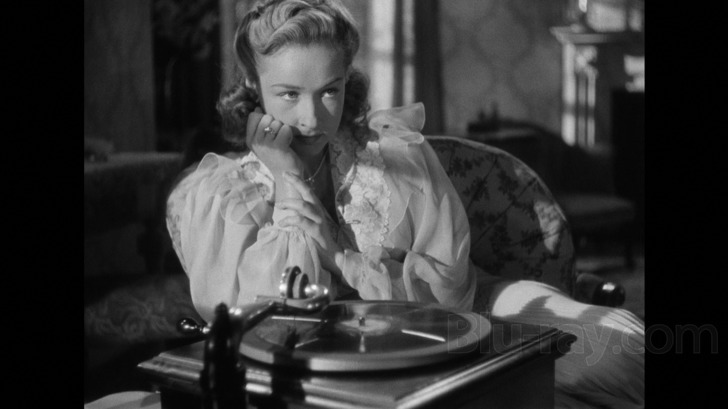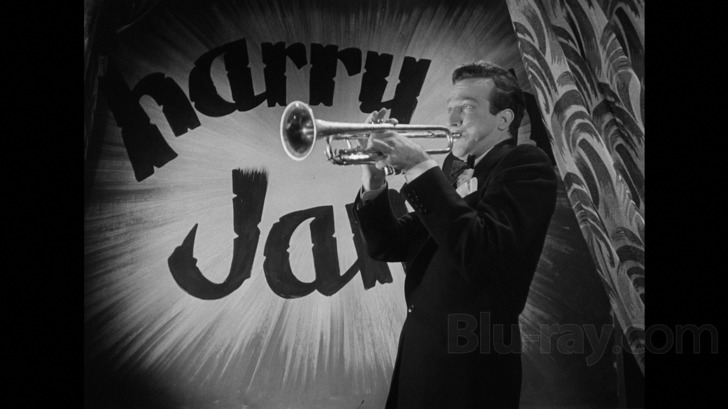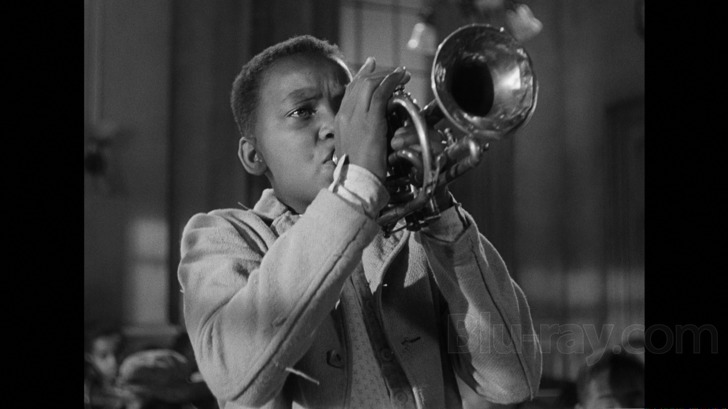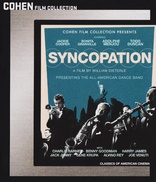Syncopation Blu-ray Movie
HomeSyncopation Blu-ray Movie 
Cohen Media Group | 1942 | 88 min | Not rated | Feb 10, 2015Movie rating
6.6 | / 10 |
Blu-ray rating
| Users | 0.0 | |
| Reviewer | 3.0 | |
| Overall | 3.0 |
Overview
Syncopation (1942)
This musical chronicles the history of jazz music and features many of the most popular musical acts from the early 1940s, including Gene Krupa and Benny Goodman. The story centers on a trumpet player who falls for a young woman with an equal passion for music. Unfortunately, the girl is still grieving for her true-love whom she lost during the war. The trumpeter begins working to get the girl to trust her. He simultaneously tries to start a band. Songs include: "Goin' Up the River" (Dave Torbett, Leith Stevens), "You Made Me Love You" (Joseph McCarthy, James V. Monaco), "Only Worry for a Pillow," "Chicago Ragtime" (Stevens), "Under a Falling Star" (Rich Hall, Stevens, sung by Connie Boswell), and "Slave Market" (Hall Johnson).
Starring: Adolphe Menjou, Jackie Cooper, Bonita Granville, George Bancroft, Robert BenchleyDirector: William Dieterle
| Romance | Uncertain |
| Musical | Uncertain |
| Music | Uncertain |
| Comedy | Uncertain |
| History | Uncertain |
Specifications
Video
Video codec: MPEG-4 AVC
Video resolution: 1080p
Aspect ratio: 1.37:1
Original aspect ratio: 1.37:1
Audio
English: LPCM 2.0 Mono
Subtitles
None
Discs
50GB Blu-ray Disc
Single disc (1 BD)
Playback
Region A (locked)
Review
Rating summary
| Movie | 3.0 | |
| Video | 4.0 | |
| Audio | 3.5 | |
| Extras | 3.0 | |
| Overall | 3.0 |
Syncopation Blu-ray Movie Review
Reviewed by Jeffrey Kauffman February 8, 2015There was a time when the terms “collectivist” and “collectivism” did not have the pejorative connotations that they acquired in a post- Communist (not to mention post-Ayn Rand) universe. Back when Communism was “cool,” an era which probably extended in the United States at least through the 1930s, artists especially were fond of pointing toward the group efforts to create Art in the Soviet Union, and in fact troupes like the vaunted Group Theater (a not exactly coincidental moniker) promoted the idea of a collectivist aggregation that shunned traditional ideas of billing order and show business strata that typically accompanied any production in any medium. Something akin to that “we’re all in this together” ethos is on display from the first moment of Syncopation, an odd but enjoyable William Dieterle film from 1942. Instead of the traditional credits roll, the viewer is instead greeted by a list of names without any actual “job” listed. The list of names is split between those “in front” of the camera and “behind” it, but otherwise the list is presented simply as a collaborative detailing. That might be seen as an analog to the putative subject of the film, jazz, especially in idioms like Dixieland or New Orleans jazz, where several musicians unspool simultaneous improvisations. There’s certainly not anything overly improvisatory about the rather trite and tame (and potentially slightly offensive at times) story line of Syncopation, but there are some very winning if awfully brief performances from Swing Era superstars of the day, including such iconic names as Benny Goodman, Charlie Barnet, Gene Krupa and Harry James.

Syncopation elides a contentious slew of world and American history in its first montage, charting the horrifying slave trade which in turn gives way to an African American-centric music school in New Orleans which is evidently housed in offices once devoted to auctioning off actual human beings to the highest bidder. A charming little boy named Reggie Tearborn (rather incredibly both the film's official credits and the IMDb fail to list the winning young actor playing this role, though according to TCM it’s Jack Thompson) is straying from the printed music in front of him to jam for a little while on his cornet, something that leads his kindly elderly teacher to suggest he might be wasting his time learning classical music.
When Reggie shows up at the local black church and rescues a preacher who had hired another (absent) trumpeter to “sub” for the Angel Gabriel in a kind of revival meeting, one thing leads to another and the little boy is offered a job in the local band, which is performing a kind of nascent jazz. Reggie’s mother Ella (Jessie Grayson) is obviously distraught but takes the band leader’s advice that her little boy has been given a divine spark of sorts and it needs to be fostered. Meanwhile Ella has found out that her employer, George Latimore (Adolphe Menjou), will be moving to Chicago from New Orleans. Ella is housekeeper and Gone with the Wind-esque “mammy” figure to widower George’s daughter Kit (Peggy McIntyre as a child, Bonita Granville as a young woman). Kit is also an aspiring musician, a talented pianist who specializes in so-called “New Orleans style” (which in this case is a kind of stride based two step that is somewhat reminiscent of Ragtime).
As a little girl in New Orleans, Kit has already met a little boy named Paul, and once the film segues forward several years, Paul (played as a young man by Ted North) has become romantically involved with Kit. That doesn’t stop him from going on a business dinner meeting with his father rather than stick around with his betrothed for her birthday celebration, and Kit, in a bit of a funk, sets out at night on an aimless walk, a trek which ultimately brings her into contact with Johnny (Jackie Cooper). Johnny initially seems like a street tough, but he escorts Kit through the semi-mean urban streets and to a jam session of sorts where Kit’s unbridled mastery of the keyboard gets her— arrested! The subtext here is not particularly subtle, and in fact some may find it somewhat humorous. Jazz was considered dangerous.
Kit’s supposed legal troubles have a rather whimsical (and again somewhat humorous) resolution, but soon world shaking events overtake the story, with World War I looming on the horizon and tragedy visiting Kit’s life as a result. Kit and Johnny end up as the focal couple, and Johnny’s attempt to forge a music career provides most of the impetus for the film’s closing act. Syncopation’s depiction of the evolution of early 20th century “jazz” (in various forms ultimately leading to the then au courant Swing idiom) is not exactly the stuff of historical accuracy, but the film is notable for offering some really ebullient performances, even if it tends to forget the link between the African American slave and the music that arose from their shared experiences. This is a somewhat odd situation given the fact that Syncopation offers just such a link in its early going, following through with the story of little Reggie, before pretty much jettisoning that arc in favor of the story of Kit (to be fair, Reggie does show up briefly as an adult). The tenor of the times probably prevented the film from focusing solely on a black musician, but Syncopation tends to subvert some of its potential emotional impact by shifting the story over to an obviously middle class white lass and her somewhat less well appointed boyfriend who have “appropriated” Ragtime and other black influenced music for their own purposes.
Syncopation Blu-ray Movie, Video Quality 

Syncopation is presented on Blu-ray courtesy of Cohen Film Collection with an AVC encoded 1080p transfer in 1.37:1. According to the re- release trailer included on this Blu-ray, Cohen invested in a 2K restoration of this largely forgotten film, and the results are very commendable. Contrast is strong, with deep, convincing blacks and nicely modulated gray scale. Detail and clarity are also pleasing, though the transfer struggles at times to provide substantial shadow detail in some of the darkest sequences. There are still some minimal signs of age related wear and tear which crop up occasionally, but they're transitory and never very distracting. There are similarly no issues with image instability or compression issues. Very occasionally the at times thick grain field can look slightly unnatural, a tendency which is limited to (again) darker scenes.
Syncopation Blu-ray Movie, Audio Quality 

Syncopation features an LPCM 2.0 Mono mix that doesn't offer much in the way of depth but which is free from major damage in the form of clicks, pops or dropouts. There's a fairly tinny sound to a lot of the music, especially the brass material, but it's never overly problematic. Dialogue comes through just fine, with no problems to report. There are no subtitles on this release, a rarity for a Cohen offering.
Syncopation Blu-ray Movie, Special Features and Extras 

- Rhapsody in Black and Blue (1080p; 10:06) features Louis Armstrong.
- Symphony in Black (1080p; 9:37) features Duke Ellington.
- A Bundle of Blues (1080p; 9:11) features Duke Ellington.
- Black and Tan Fantasy (1080p; 19:04) features Duke Ellington in his first screen appearance.
- St. Louis Blues (1080p; 15:43) features Bessie Smith.
- Cab Calloway's Hi-De-Ho (1080p; 9:56) features Cab Calloway, of course.
- Artie Shaw's Class in Swing (1080p; 10:11) features Artie Shaw, of course.
- Hoagy Carmichael (1080p; 10:04) features the venerable songwriter with Jack Teagarden and his orchestra.
- Jazz A La Cuba (1080p; 5:20) features Don Aspiazu, "foremost exponent of the Rhumba."
- 2015 Re-Release Trailer (1080p; 1:29)
Syncopation Blu-ray Movie, Overall Score and Recommendation 

As "history," Syncopation is pure unadulterated hokum, and at times fairly humorous hokum at that. The film also has some potentially off putting material early on with its depiction of an African American revival service which may rankle some as being precariously close to moving into politically incorrect (or at least insensitive) territory. Syncopation's "marquee" stars, i.e., Goodman, James, Barnet, Krupa, et al., are basically consigned to the final couple of minutes of the film, a supposed "jam" session of superstars who won some kind of Saturday Evening Post poll to appear in the film. That leaves a kind of clunky but enjoyable love story between the Granville and Cooper characters, augmented by lots of at times whimsical musical elements. It's a somewhat uneven stew, perhaps one sign that this particular "collective" wasn't quite able to hit the bullseye. Still, there's a lot to enjoy here for those who can put aside various qualms. Technical merits are strong and the supplemental package of great musical shorts is a real treat. Recommended.
Similar titles
Similar titles you might also like
(Still not reliable for this title)

Strike Up the Band
Warner Archive Collection
1940

Victor/Victoria
1982

Ninotchka
1939

Swing Time
1936

You'll Never Get Rich
1941

The Boy Friend
Warner Archive Collection
1971

Twentieth Century
1934

By Candlelight
1933

The Band Wagon
1953

Girls Just Want to Have Fun
1985

Cover Girl
Limited Edition to 3000 - SOLD OUT
1944

Mike & Molly: The Complete First Season
2010

The Awful Truth
1937

Love Me Tonight
1932

Straight Talk
1992

42nd Street
Warner Archive Collection
1933

Sleeping with Other People
Rental Copy
2015

The Rewrite
2014

My Sister Eileen
1955

Continental Divide
1981
